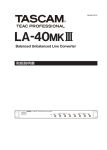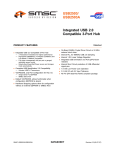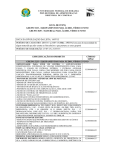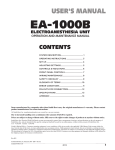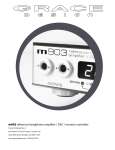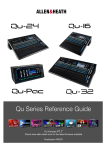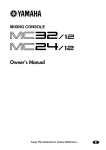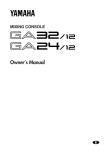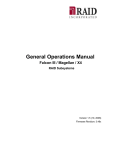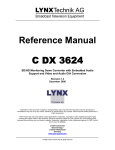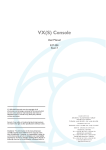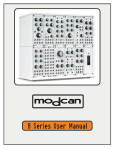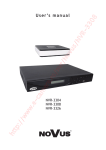Download Manual (english)
Transcript
Manual Mixer Live M416 2 / 45 Table of contents 1. Warranty ........................................................................................................................................... 7 2. Safety instructions ............................................................................................................................ 7 3. 2.1. FOR SAFE AND EFFICIENT OPERATION ............................................................................ 7 2.2. Important mains plug wiring instructions ................................................................................. 8 Introduction ....................................................................................................................................... 9 3.1. 4. Foreword.................................................................................................................................. 9 View of the mixing console ............................................................................................................... 9 4.1. Front view ................................................................................................................................ 9 4.2. Back view................................................................................................................................. 9 5. Introduction to the mixing console.................................................................................................. 10 6. Installing the console ...................................................................................................................... 11 7. 8. 9. 6.1. Grounding .............................................................................................................................. 11 6.2. Switching the console on or off.............................................................................................. 12 Audio connections .......................................................................................................................... 12 7.1. General overview ................................................................................................................... 12 7.2. Required connection cables .................................................................................................. 14 7.3. Dealing with ground loops, buzz and interference ................................................................ 14 7.4. Balanced connections ........................................................................................................... 15 Connections at the mixing console ................................................................................................ 15 8.1. MONO CHANNEL MIC/LINE IN ............................................................................................ 15 8.2. STEREO CHANNEL MIC IN/OUT; LINE IN .......................................................................... 15 8.2.1. STEREO CHANNEL MIC IN ......................................................................................... 15 8.2.2. STEREO CHANNEL MIC OUT ..................................................................................... 15 8.2.3. STEREO CHANNEL LINE IN ........................................................................................ 16 8.3. INSERT.................................................................................................................................. 16 8.4. DIRECT OUTPUT ................................................................................................................. 16 8.5. LAMP ..................................................................................................................................... 16 8.6. GROUP; L; R; M OUT ........................................................................................................... 16 8.7. AUX OUT 1-6......................................................................................................................... 17 8.8. MATRIX OUT 1-4 .................................................................................................................. 17 8.9. MATRIX EXT IN 1-4 .............................................................................................................. 17 8.10. 2-TRACK IN and OUT ........................................................................................................... 18 8.11. MONITOR OUT ..................................................................................................................... 18 Input channel .................................................................................................................................. 19 9.1. Mono ...................................................................................................................................... 19 9.1.1. +48V .............................................................................................................................. 19 9.1.2. Polarity ........................................................................................................................... 19 3 / 45 9.1.3. Line (PAD) ..................................................................................................................... 19 9.1.4. Gain ............................................................................................................................... 19 9.1.5. HPF ................................................................................................................................ 20 9.1.6. EQ .................................................................................................................................. 20 9.1.7. AUX Sends .................................................................................................................... 20 9.1.8. PRE ............................................................................................................................... 20 9.1.9. PAN ............................................................................................................................... 20 9.1.10. MUTE ............................................................................................................................. 21 9.1.11. PFL ................................................................................................................................ 21 9.1.12. Meter .............................................................................................................................. 21 9.1.13. Routing .......................................................................................................................... 21 9.1.14. Fader ............................................................................................................................. 21 9.2. Stereo .................................................................................................................................... 22 9.2.1. Mic input ........................................................................................................................ 22 9.2.2. Dual stereo line inputs ................................................................................................... 22 9.2.3. Routing mode switch ..................................................................................................... 22 9.2.4. EQ .................................................................................................................................. 23 9.2.5. AUX Sends .................................................................................................................... 23 9.2.6. BAL ................................................................................................................................ 23 9.2.7. Mute ............................................................................................................................... 23 9.2.8. PFL ................................................................................................................................ 23 9.2.9. Meter .............................................................................................................................. 23 9.2.10. Routing .......................................................................................................................... 23 9.2.11. Fader ............................................................................................................................. 23 10. Master section ........................................................................................................................... 24 10.1. Group/Aux Masters ................................................................................................................ 24 10.1.1. AUX Masters .................................................................................................................. 24 10.1.2. AUX AFL ........................................................................................................................ 24 10.1.3. REV ............................................................................................................................... 24 10.1.4. PAN ............................................................................................................................... 24 10.1.5. Meter .............................................................................................................................. 25 10.1.6. MUTE ............................................................................................................................. 25 10.1.7. GROUP AFL .................................................................................................................. 25 4 / 45 10.1.8. 10.2. Fader ............................................................................................................................. 25 AUX 5-6 Master, L-R-M-Master ............................................................................................. 26 10.2.1. AUX 5 und 6 Master ...................................................................................................... 26 10.2.2. LR Masters .................................................................................................................... 26 10.2.3. Master ............................................................................................................................ 26 10.3. 7x4 Matrix .............................................................................................................................. 27 10.3.1. EXT IN ........................................................................................................................... 27 10.3.2. GRP 1 (2, 3, 4)............................................................................................................... 28 10.3.3. L (R) ............................................................................................................................... 28 10.3.4. Level .............................................................................................................................. 28 10.3.5. Mute ............................................................................................................................... 28 10.3.6. AFL ................................................................................................................................ 28 10.4. Monitor, Talkback und Signal Generator ............................................................................... 29 10.4.1. Monitor ........................................................................................................................... 29 10.4.2. Talkback ........................................................................................................................ 29 10.4.3. Signal Generator/Pink Noise ......................................................................................... 30 11. Applications and operating tips.................................................................................................. 30 11.1. Gain structure ........................................................................................................................ 30 11.2. Using the Oscillator/Noise Generator .................................................................................... 31 11.3. Mixing with faders or gain controls? ...................................................................................... 32 11.4. Using PFL/AFL ...................................................................................................................... 32 11.5. Decibel ................................................................................................................................... 33 11.6. Using Inserts .......................................................................................................................... 34 11.7. Polarity ................................................................................................................................... 34 11.8. Mixing the PA in mono or stereo? ......................................................................................... 34 11.9. Zero the console .................................................................................................................... 35 11.10. Turning the system on and off ........................................................................................... 35 11.11. Sound levels ...................................................................................................................... 35 11.12. Dual functionality ............................................................................................................... 35 11.13. Applications for the Matrix ................................................................................................. 37 11.13.1. Mono Recording ........................................................................................................ 37 11.13.2. Stereo Recording ....................................................................................................... 37 11.13.3. Remote Broadcast ..................................................................................................... 37 11.13.4. Zone feeds ................................................................................................................. 38 11.13.5. Delay Fill speakers .................................................................................................... 38 11.13.6. Hearing assist ............................................................................................................ 38 5 / 45 11.13.7. Additional monitor mixes ........................................................................................... 38 11.13.8. Combining two consoles into a single PA ................................................................. 38 11.13.9. Create IEM mixes with ambience .............................................................................. 39 11.13.10. Using the matrix to create a recording ...................................................................... 39 11.14. Recording with the mixing console .................................................................................... 39 11.15. Pre/post fade Aux settings ................................................................................................. 39 11.16. Aux-Fed Subs .................................................................................................................... 40 11.17. Creating a separate C mix ................................................................................................. 40 11.18. Other M output applications ............................................................................................... 41 12. Technical Data ........................................................................................................................... 42 12.1. Performance .......................................................................................................................... 42 12.2. Connections ........................................................................................................................... 43 13. Circuit diagram........................................................................................................................... 44 6 / 45 1. Warranty Limited one year warranty This product is warranted to be free from defects in materials or workmanship for a period of one year from the date of purchase. To ensure a high level performance and reliability, for which this equipment has been designed and manufactured, read this user guide before operating. Conditions of warranty Damages caused by the disregard of this user manual are not subject to warranty. The dealer will not accept liability for any resulting defects or problems. Make sure the electrical connection is carried out by qualified personnel. All electrical and mechanical connections have to be carried out according to the European safety standards. 2. Safety instructions • Read the safety instructions and also this manual carefully. • Keep the manual. • Observe all red flags. • Observe the manual. • To prevent fire or electric shocks, protect the device against rain and humidity • Pull the plug before opening the housing. • To prevent an electric shock you should not remove the cover. • Do not operate the device in the near of water. • Use only a dry cloth for cleaning. 2.1. FOR SAFE AND EFFICIENT OPERATION Be careful with heat and extreme temperature Avoid exposing it to direct rays of the sun or near a heating appliance. Not put it in a temperature bellow 32°F /0°C, or exceeding 104°F /35°C. To avoid placing on un-stable location Select a level and stable location to avoid vibration. Do not use chemicals or volatile liquids for cleaning Use a clean dry cloth to wipe off the dust, or a wet soft cloth for stubborn dirt. Pull the plug before cleaning. 7 / 45 If out of work, contact sales agency immediately Any troubles arose, remove the power plug soon, and contact with an engineer for repairing, do not open the cabinet by yourself, it might result a danger of electric shock. Take care with the power cable Never pull the power cable to remove the plug from the receptacle, be sure to hold the plug. When not using the device for an extended period of time, be sure to disconnect the plug from the receptacle. Ventilation It is not allowed cover fans and air in and outlets. Safety Do not remove the grounding. It is for your safety. If you remove the grounding it can cause electric shocks. Hearing To avoid hearing damages, you should not operate a sound system with high levels. This applies to monitor systems, which are in the near of the ear, headphones or IEMs also. 2.2. Important mains plug wiring instructions The console is supplied with a molded mains plug fitted to the AC mains power lead. Follow the instructions below if the mains plug has to be replaced. The wires in the mains lead are colored in accordance with the following code. Terminal L Live N Neutral PE Earth GND Wire Color European Brown Blue Green/Yellow USA/Canada Black White Green The wire which is colored green and yellow must be connected to the terminal in the plug which is marked with the letter E or with the earth symbol. The appliance must be earthed. The wire which is colored blue must be connected to the terminal in the plug which is marked with the letter N. The wire which is colored brown must be connected to the terminal in plug which is marked with the letter L. Ensure that these color codes are followed carefully in the event of the plug being changed. 8 / 45 3. Introduction 3.1. Foreword Welcome to the professional mixing console of the latest generation of the popular series of dual function live sound mixing consoles. We have tried to keep this user guide brief and to the point. Please read it carefully before starting. Included is information on installing, connecting and operating the console, panel drawings, system block diagram and technical specification. For further information on the basic principles of audio system engineering, please refer to one of the specialist publications and resources available from bookshops, audio equipment dealers and the internet. We reserve the right to make changes on the manual. 4. View of the mixing console 4.1. Front view 4.2. Back view 9 / 45 5. Introduction to the mixing console The mixing console is an analogue mixing console designed for professional audio applications. Whether mixing FOH, monitors or both, recording live or in the studio, installed in a busy venue, out on the road touring, or earning its keep in rental stock, the mixing console provides the perfect solution. Engineered to the same standards as our top of the range consoles it ensures the highest reliability and finest sonic performance. • 16 channels • LR Main-Mix • Multi-Mode M output • 4 Group-Sends • 6 AUX-Sends • 7x4 Matrix • Proper dual functionality for FOH/Monitor mixing • Recording capable • M can be configured as LR sum, C mix; Wedge; or Aus-Fed Sub master • Sub grouping with pan control • Gain for every channel • 2 stereo channel each with mic and dual stereo line inputs • Stereo channel line inputs can be assigned independently to LR • Responsive 4 band, 2 sweep EQ • 100Hz channel high pass filter • Phantom power • Polarity switch • Channel and master meters • Chanel direct outputs • Per channel pre/post fader Aux switching 10 / 45 • Mutes on all fader meters • 100mm dust protected faders • Assignable talkback • 1kHz oscillator 7 pink noise generator • 2-Track monitoring and replay to LR • Headphones and local monitor outputs • Dedicated stereo monitor meters • Electronically balanced XLR outputs with +26dBu/+15,5V drive capability • Preamp +34dBu/+38,9V maximum input capability for mic or line • Metal jacks, gold-plated XLRs, sealed pots and switches • Solid copper bus grounding 6. Installing the console The mixing console has a space saving, compact chassis design. The control surface has a 10 degree slope for optimum visibility during operation. The rear connector panel has a split angle design for ease of plugging and unplugging the connectors. The console has rubber feet fitted for free standing operation on a flat surface. Make sure the surface is well supported, stable and big enough for the console to slit securely on all its feet. Do not obstruct the ventilation openings on the top and rear surfaces. To avoid audible hum, buzz or other performance degradation, do not place equipment that radiates strong electromagnetic fields such as mains power supplies, amplifiers and computers next to or directly underneath the console. Read and understand the important safety instructions printed at the start of this guide, and the warnings printed on the rear of the console. Check the console power supply mains voltage input is the same as your local supply. Check that the correct mains lead with molded plug has been provided with your console. Make sure that IEC mains plug is pressed fully into the panel socket before switching on. 6.1. Grounding The connection to the ground in an audio system is important for two reasons. 1. Safety To protect the operator from high voltage electric shock. 2. Audio performance to minimize the effect of ground (earth) loops which result in audible hum and buzz, and to shield the audio signals form interference. For safety it is important that all equipment grounds are connected to mains ground so that exposed metal parts are prevented from carrying high voltage which can injure or even kill the operator. Do not disconnect the ground connection in the mains lead. . 11 / 45 6.2. Switching the console on or off Turn power amplifiers off before switching the console and any other connected equipment on or off. Note: Turn amplifiers and powered speakers on last and off first! To turn the console on, press the ON/OFF switch next to IEC mains input socket. To turn the console off, press the switch again. 7. Audio connections 7.1. General overview 12 / 45 13 / 45 7.2. Required connection cables The mixing console uses professional grade 3 pin XLR and ¼'' TRS (3 pole) jack sockets. To ensure best performance, we recommend that you use high quality audio cables and connectors, and take time to check reliable and accurate cable assembly. It is well known that most audio system problems are due to faulty or sub standard interconnecting leads. The following plugs may be used to connect audio to the console: Avoid reversing + and – on balanced connections as this will result in reserved polarity (out of phase) signals which may cause signal cancellation effects. Where long cables runs are required, balanced interconnections should be used. However, line level interconnections between more affordable 2-wire (signal, ground) unbalanced equipment and the console unlikely to cause the problems if the cables are kept shorter than 10 meters or so. Refer to the wiring diagrams in chapter 7. 7.3. Dealing with ground loops, buzz and interference For optimum performance all audio signals should be referenced to a solid, noise-free ground (earth) point, frequently referred to as the “star point” or “clean earth”. A ground loop is created when potential differences exist between grounds at different points in the system, and the signal has more than one path to the ground. In most cases ground loops do not result in audible problems. Should you experience hum or buzz caused by a ground loop, check first that each piece of equipment in accordance with the instruction manuals. Important: For operator safety, do not remove the ground (earth) connection in the power lead of the console or connected equipment. To avoid interference pickup keep audio cables away from mains power units and cables, lighting cables, dimmer units, computer equipment and mobile phones. Where this cannot be avoided, cross the cables at right angles to minimize interference. 14 / 45 7.4. Balanced connections A differentially balanced connection hast two signal wires + (hot) and signal – (cold) and a shield. The signal source generates positive going polarity down the + wire and negative polarity down the – wire. The destination input stage accepts the + signal on its non-inverting (+) input pin but it inverts the – signal, adding it to the + signal. The result is that the wanted signal is boosted. 8. Connections at the mixing console 8.1. MONO CHANNEL MIC/LINE IN The LINE (PAD) switch selects either the MIX XLR or the LINE TRS jack as the input source. The XLR is normally through the TRS jack so it can be used for microphone or line level signals when nothing is plugged into the jack socket. This gives the channel preamp a massive headroom with +34dB maximum input capability using XLR or jack. Both inputs are balanced but can be wired to work with unbalanced signals when required. The MIC XLR can be switched to provide +48V phantom power for condensers. Note: Do not connect unbalanced sources or cables to XLR input when 48V phantom power is selected. To avoid loud clicks always turn the channel off by pressing MUTE when switching +48V on or off, and when plugging or unplugging cables. 8.2. STEREO CHANNEL MIC IN/OUT; LINE IN 8.2.1. STEREO CHANNEL MIC IN Each stereo channel features a mono microphone XLR input and two independent stereo line inputs. The balanced MIC input accepts a maximum +14dBu/3,9V and can be switched to provide 48V phantom power 8.2.2. STEREO CHANNEL MIC OUT The output of the mic preamp is available on the MIC OUT (BREAKPOINT) TRS jack socket. This is impedance balanced and operates at a nominal 0dBu/0,77V line level. Plugging into this socket breaks the signal into the associated stereo channel. That means that the mic preamp can be used independently of the channel. 15 / 45 8.2.3. STEREO CHANNEL LINE IN Stereo inputs ST1 and ST2 feed channel 15, and ST3 and ST4 feed channel 16 respectively, or can be routed directly to LR. These inputs use TRS jacks. ST1, 3 are unbalanced, ST2, 4 are balanced. Unbalanced inputs automatically connect the TRS ring to ground when working with balanced sources. The L input is normally through the R socket to accept mono signals on a single jack. 8.3. INSERT A single 3-pole TRS insert jack carries the unbalanced insert signal for each mono channel and main mix output. Tip = send, ring = return, Sleeve = common ground. The channel inserts are post HPF, pre EQ and operate at 0dBu/0,77V. The group (AUX) and LR mix inserts are pre-fader and operate at -2dBu/0,62V. Use these to patch in line level signal processing equipment such as compressors, outboard EQ, delay units and so on. The wiring of a suitable cable is shown in the diagram. 8.4. DIRECT OUTPUT Each mono channel direct output is available on an impedance balanced TRS jack providing a line level signal operating at 0dBu/0,77V. The output is set pre-fade. 8.5. LAMP The console has one 4pin XLR socket to plug in standard 12V gooseneck lamps to illuminate the operating surface when working in a dark environment. Only use the lamps intended for this purpose. We recommend the LED lamp with cool white LED illumination and a built in dimmer. 8.6. GROUP; L; R; M OUT The main console mix outputs are on electronically balanced XLR. These produce the professional standard +4dBu/1,23V when the meters read 0, and provide to a maximum +25dBu/13.77V. The L and R outputs typically feed the house PA system in live sound mixing, or a 2-track recorder in studio mixing. In monitor mode, these outputs reverse with the AUX TRs jack connections. 16 / 45 Operating modes In the FOH mode, LR feeds the main PA. M sums the L and R post-fade signals to provide an additional feed for a mono fill speaker or zone, or main feed into a mono PA. Groups 1-4 may be used for multitrack recording, zone feed and so on, or simply left unconnected where they are used as subgroups to LR for level masters and/or inserted processing. In monitor mode Groups 1-4 and LR XLRs and inserts become the aux mix masters. M becomes the engineer’s listen wedge AFL/PFL feed. This configures the console with 6 main stage monitor and an engineer’s output. The groups and LR are still available via the matrix to provide yet more monitor feeds 8.7. AUX OUT 1-6 Each AUX send is available on an impedance balanced TRS jack operating at -2dBu/0,62V line level. The Aux senda are typically used to feed monitors, effects devices such as reverb and delay. 8.8. MATRIX OUT 1-4 Each matrix output is available on an impedance balanced TRS jack operating at -2dBu/0.62V line level. The matrix outputs are typically used for mono or stereo recording or broadcast feeds, delay and fill speakers, zone feeds, additional monitors such as IEM, hearing assist loops and so on. 8.9. MATRIX EXT IN 1-4 Each matrix has an unbalanced 0dBu/0,77V line level TRS jack input. An external signal such as ambience mix, additional or sub mixer, remote source, reference tone and so on may be mixed in to each matrix. The inputs are normally as shown in the diagram here. This means you can plug in just one jack (EXT!) as a common source to all matrix, two jacks (EXT1, 2) as a common stereo source to matrix pairs, or four independent sources. This is ideal for adding mono or stereo ambience to recordings or in-ear monitor fed from the matrix. 17 / 45 8.10. 2-TRACK IN and OUT Unbalanced TRS jack outputs and TRS jack inputs connect to popular recording and playback devices such as CD, Minidiscs, computers and tape machines. Nominal line level is -2dBu/0,62V. The 2-track send always follows the post fade LR mix regardless of mode switch configuration. The 2track return can be used for monitoring a mono or stereo recording, o as a simple input for playback of walk-in and background music. The L input normally through the R socket for plugging in a mono source on a single jack. 8.11. MONITOR OUT These impedance blanced line level TRS jack outputs follow the post-level monitor signal. Separate sockets are provided fot the L and R signals. Use these to feed local speaker or other monitor systems. 18 / 45 9. Input channel 9.1. Mono 9.1.1. +48V Switches +48VDC to the channel input XLR to powering microphones or DI boxes that need phantom power. The power is current limited through 6kΩ resistors to pins 2 and 3. Warning: Do not connect unbalanced sources or cables to inputs with phantom power selected. To avoid loud clicks always mute the channel before switching +48V on or off and when plugging or unplugging microphones. 9.1.2. Polarity Reverses the polarity (+ and – connections) of the input source. Useful when you are using the above/below mic technique, for example when take a snare drum with two microphones, or for correcting mic placement and cable wiring errors. 9.1.3. Line (PAD) Press the switch to select the channel TRS jack line input. Release the switch to select the XLR Mic input. The XLR is normal through the TRS socket. With nothing plugged into the line input the switch therefore becomes a Pad for the Mic XLR. It attenuates the input signal by 20dB for connection to high level microphone or line sources. This gives the mic preamp a massive 74dB range and headroom of +34dB to deal with the hottest signals. 9.1.4. Gain Adjusts the input sensitivity to match the connected source to the internal 0dBu/0,77V operating level of the channel. Provides a variable 54dB range from +dB to +60dB gain (mic), or -14dB to 40dB (line, padded mic). The gain should be set so that the channel meters average ‘0’ with the loudest moments lighting ‘+6’. Reduce gain if the red peak indicator lights. Important note on setting channel levels: Use PFL to set the gain controls before correct signal level through each channel. The main LR meters provide a high resolution display of the channel signal level. Use the faders to balance each signal in the mix. To ensure optimum 19 / 45 gain structure we do not recommend the practice of setting the faders to ‘0’ and mixing using the gain controls. 9.1.5. HPF Switch the channel high pass filter on. This attenuates frequencies below 100Hz by 12dB per octave. The filter is pre-insert, pre-EQ. Select the HPF to reduce low frequency noise such as microphone popping, stage noise and tape transport rumble. 9.1.6. EQ A responsive 4-band semi parametric EQ provides independent control of four frequency bands. HF and LF are shelving filters which affect high frequencies above 12 kHz, and low frequencies below 80Hz respectively. HM and LM are bell shaped peak/dip filters which affect frequencies around a centre point which can be swept from 500Hz to 15 kHz and 35 Hz to 1 kHz respectively. These have a width (Q) of 1.8 which provides effective control for both creative and corrective equalization. 9.1.7. AUX Sends These rotary controls adjust how much channel signal is mixed to the aux outputs. Each of the 6 aux has its own control. The adjust from fully off to +6dB boost. Unity gain 0dB is marked at 3 o’clock position. Aux 1-4, 5-6 are switched pre/post. Pre-fade aux sends are not affected by the channel fader movements. These are typically used to feed stage monitors. In most cases users also prefer that the monitor sends are not affected by inserted processors or the channel EQ. Post-fade aux sends follow the channels faders and are typically used to send a proportion of the channel signal to an effects device such as a reverb or delay. Note that post-fade sends may be preferred when the console is configured in monitor mode so that the faders become ‘masters’ for all monitor mixes. Pr or post-fade sends may also be used for special applications such as recording, zone feed, clean feed and aux fed subs or centre speaker. 9.1.8. PRE When pressed, the pre-fade channel signal is sent to the associated aux. When it is released, the post-fade signal is sent. Aux 1 to 4 and 5, 6 are grouped for pre/post switching. Default setting is preinsert, pre EQ so that inserted compressors and EQ do not affect the sends when mixing monitors from FOH. 9.1.9. PAN Positions the channels signal between L/R in the stereo mix. 20 / 45 9.1.10. MUTE When pressed, the channel signal is turned off. This affects the feed to LR mix; pre and post fade aux sends and direct output, but does not affect the insert send. The red indicator lights when the channel is muted. Always mute the channel when switching phantom power or plugging the cables and sources. 9.1.11. PFL Press PFL to listen to the pre-fade channel signal in the headphones and local monitor without affecting the main outputs. The console PFL/AFL active red indicator lights and the monitor LR meters display the channel signal. The PFL switch yellow indicator lights to show that PFL has been selected on that channel. Selecting more than one PFL, at the same time mixes those signals together in the monitor. 9.1.12. Meter A 4 LED channel meter displays the pre-fader signal level. 'SIG' lights when a signal of -12dBu/0.2V is detected. ‘0’ lights when the nominal 0dBu level is reached, and ‘+6’ at +6dBu/1.5V. ‘PK’ lights when the channels pre-fade signal within 5dB clipping. This gives you enough warning to reduce gain before you hear signal distortion. 9.1.13. Routing Press L-R to route the channel signal to the main LR mix. Press 1-2 or 3-4- to route to the groups. Use Pan to position the signal between L/R and the odd/even group pairs. To route to a single group set Pan fully to one side. You can route to L-R and all groups simultaneously by pressing all switches. Check that you have the switches correctly before you start mixing. 9.1.14. Fader A high quality 100mm smooth travel fader with protective dust cover controls the channel level feeding the main LR mix, groups and post-fade aux sends. The fader provides +10dB maximum boost above its normal unity gain 0dB position. 21 / 45 9.2. Stereo Each stereo channel features a mono microphone preamp as well as two stereo line inputs. These three sources can be used independently or mixed together into channel, so providing a unique flexibility. For example, you could configure a conventional mono microphone channel with the two ‘short return’ stereos routed direct to LR for effects. Alternatively you could patch the mic stage as an independent preamp for an ambience microphone feeding a recording, or for a system calibrate microphone, while ST line inputs mix two external stereo effects processor return or sound effect players via a single channel. This can be useful in saving chennel, letting you mix many inputs in a small space. Of coursek, one stereo could feed the chennl, the other route direct to LR. Two stero channels could be linked so that the mic premps cross patch to provide one stereo mic and one stereo line channel, with two ‘short returns’ also available. 9.2.1. Mic input Similar to the mono channel microphone preamp without the line (pad) and polarity switches. Gain and 48V phantom power switching are included. A rear panel mic out breakpoint socket is provided so that the mic stage can be used independently. Plugging a jack into the mic out socket breaks its signal path to the stereo channel. 9.2.2. Dual stereo line inputs Each stereo channel has two stereo inputs which can be used separately, mixed together or split so that one feeds the channel, the other routes direct to LR, ST1 and 2 feed channel 15 (23), ST3 and 4 feed channel 16 (24). The L input signal is normally through the R input socket so that a mono source may be plugged in to feed both left and right sides of the stereo channel. Each input has its own level control to adjust from fully off to +16dB gain. Centre position is unity (0dB) gain. 9.2.3. Routing mode switch Recessed to prevent accidental operation. In normal up position the ST signal mixes into the associated stereo channel. When pressed the signal is routed direct to the LR mix instead of the channel. 22 / 45 9.2.4. EQ Similar to the mono channel, but the twp peak/dip mid bands are fixed at 250Hz and 2.5 kHz centre frequencies. 9.2.5. AUX Sends These work as described for the mono channel, but the L and R sides of the stereo signal sum together to feed each aux in mono. 9.2.6. BAL It balances the level of the L signal against the R signal to compensate differences in the source, or to position the signal within the stereo image. 9.2.7. Mute When pressed, all the channel pre and post-fade signals are turned off except the mic out and any stereo routed direct to LR. 9.2.8. PFL Press PFL to display summed L+R pre-fade channel signal on the monitor meters and listen to it in the headphones and local monitor without affecting the main outputs. 9.2.9. Meter The same as the mono channel, but the left and right signals are summed together. 9.2.10. Routing The same as the mono channel, but routes the left signal to L and odd groups, right signal to R and even groups. 9.2.11. Fader The stereo fader provides +10dB maximum boost above is normal unity gain 0dB position. 23 / 45 10. Master section 10.1. Group/Aux Masters 10.1.1. AUX Masters Each aux mix has a master level control that adjusts the output level to match external equipment, or trims the monitor, effect or other send without affecting the mix balance. Up to +10dB boost is available above the normal 0dB position. Note that this becomes the group or master in monitor mode. 10.1.2. AUX AFL Press AFL to listen the post-level aux mix in the headphones and local monitor without affecting the main outputs. The console monitor meters are interrupted with aux (group) signal. The yellow indicator lights to show that AFL has been selected on the master. USE AFL to check the signal being sent to the monitors, effects or other destination. AFL is pre-mute so that you can check the signal before sending it to its destination. 10.1.3. REV These switches reverse the function of the group and aux masters, the heart of the dual functionality pioneered by us. They are recessed to prevent accidential operation. Use a pen or pointed object to set their position. In the up position (flush with panel), the group is controlled by the fader and the aux by rotary master. This is typical for FOH mode where the faders are used for subgroups feeding the main stereo mix. When pressed, the aux uses the fader as the master and the group is moved to the rotary control. The aux mix is now presented to rear group XLR complete with insert. The group mix apppears at the aux TRS jack. This is used for monitor mode where the aux are the main mix feeding the stage monitors. You can select any combination for the FOH and monitor mode, e.g. just 3, 4 giving you two fader aubgroups, two monitor sends on faders, and main LR mix. Note: The groups always feed the matrix and the subgroups controls (PAN and GRP TO LR) regardless of the mode. This means the group mix can still perform a useful function when the console is configured in monitor mode. 10.1.4. PAN 24 / 45 Positions the group signals between L and R in the stereo mix when the GRP TO LR switch is pressed. Using pan you can create mono or stereo groups positioned as you require in the main mix. For stereo grouping, set the odd group pan fully to the left, and the even group pan fully to the right. The centre position (mono image) is for quick resetting. Note that the group mix always feeds these subgroup controls regardless of FOH or monitor mode selected. 10.1.5. Meter A 4 LED bar meter displays the post-fade group signal (FOH mode), or aux signal (monitor mode, REV pressed) 10.1.6. MUTE When pressed the group (aux) signal is turned off. This affects the feed to the output XLR, LR and matrix. The red indicator lights when the channel is muted. 10.1.7. GROUP AFL Press AFL to listen to the post-fade, pre-mute group mix in the headphones and local monitor without affecting the main outputs. Note that this becomes the aux mix in monitor mode. The console monitor meters are interrupted with the group (aux) signal. The yellow indicator lights to show that AFL has been selected on that master. 10.1.8. Fader A 100mm a smooth travel fader controls the group mix output level. Note that it becomes the aux mix master in monitor mode (REV pressed). The fader provides +10dB maximum boost above its normal unity gain 0dB position. 25 / 45 10.2. AUX 5-6 Master, L-R-M-Master 10.2.1. AUX 5 und 6 Master These functions in the same way as described for auxes 1 to 4. In monitor mode, the recessed REV switch reverses the AUX5 master with L, and AUX6 with R. Here the aux signals are presented to the L and R XLR outputs complete with their inserts. The LR mix swaps on to the Aux TRS jack outputs. Note that the LR mix always feeds the matrix and 2-track regardless of mode selected. 10.2.2. LR Masters Separate 100mm faders control the main mix L and R output levels. They provide +10dB maximum boost. Each master includes a 4 LED bar meter, an AFL switch and a MUTE switch so that L and R can be separately monitored and muted. This is most useful in monitor mode where these masters carry the AUX5 and AUX6 signals. 10.2.3. Master A 100mm fader adjusts the level of the signal to the M output XLR. The master is fully featured and includes a 4 LED bar meter, an AFL switch and a MUTE switch. The M outputs add a true touch of genius to the versatility of the mixing console. The source is selected using two mode switches above the R fader. These are recessed to prevent accidental operation. Use a pen or pointed object to set the position. FOH-Mode With both switches in the up position (flush with the panel), the post-fade L and R mix are summed together to provide a mono source. Use this to feed a mono PA, fill, delay or zone speakers or even a mono broadcast or recording send. Monitor-Mode Press the upper switch to create an engineer’s monitor listen wedge feed from the AFL/PFL mix. Note that in this mode the M AFL switch is disabled. It is common to use a wedge speaker of the same type used on the stage to listen to and check the various monitor mixes being sent to the performers. Together with the group/aux REV function, the mixing console can be configured as compact yet fully featured monitor console. AUX-Fed-Subs-Mode Press only the lower switch to configure M as the master for AUX6. This innovate feature is ideal when driving your sub bass speakers with their own mix fed from an aux, a technique becoming more popular in FOH mixing. This mode provides all the main PA masters (L, R 26 / 45 and SUB) with faders, meters, MUTE and AFL. Using these faders you can adjust the level of the main PA without losing the balance between the tops and subs. The signal is not affected by the AUX6 rotary master. However, the rotary output can still provide another sub feed with its own independent master control. Route all sources to LR in the usual way to feed the, main ‚top speakers. In addition, route sources with low frequency content such as kick drum, bass, keyboards, sound effects to the sub speakers by turning up the AUX6 send rotary on those channels. Make sure all channel aux 5-6 sends have been set for post-fader operation. Use two crossovers, one for the stereo LR mid/top frequencies, and the other for the sub feed. Set the system up so that the correct balance between tops and subs is achieved when the channel send is at it ‘0’ (3 o’clock) position and the L, R and M faders in line with each other. AUX-Fed-Centre-Mode The same principle as above, but AUX6 is used to feed a centre mix such as a fill or C in a LCR system. To route to C only, turn up the channel AUX6 send to 3 o’clock unity position, and turn off its assignment switch to LR. 10.3. 7x4 Matrix The matrix adds to the powerful multi-tasking capability of the mixing console. It provides a set of 4 additional console outputs. It is a ‘mixer within a mixer’ creating its output from any combination of the groups, main LR mix and external input. It can be used to provide duplicate main outputs or to create new mixes from these outputs. The matrix controls are positioned conveniently away from the live performance controls to avoid accidental operation. 10.3.1. EXT IN Mixes in an external nominal 0dBu/0.77V line level source. The rotary provides +6dB boost. Note that EXT IN jack sockets are normally (linked) in a way that lets you plug in a mono or stereo common source to feed all the matrices, or an independent source to each. Plug into EXT1 only to feed one source to all four matrix EXT IN controls. Plug L into EXT1 and R into EXT2 only to feed a stereo source to matrix 1-2 and 3-4. Some examples include adding ambience sources to recordings and in-ear monitoring, adding a direct output or an aux mix to quickly create a monitor from the main mix plus selected channels and linking in another console to feed the same PA in a festival or other dual console situation. 27 / 45 10.3.2. GRP 1 (2, 3, 4) Mixes in the post-fader, post-mute group mix. The rotary provides +6dB boost. 10.3.3. L (R) Mixes in the post-fader, post mute main LR mix. The rotary provides +6dB boost. Turn up both L and R to create a mono sum from the stereo LR mix. Turn up L in one matrix, R in another to create a stereo output from two matrices. 10.3.4. Level The master level control (fader) for the matrix. Provides +6dB boost above the normal ‘0‘ setting. 10.3.5. Mute When pressed the matrix output is turned off. The red indicator lights when matrix is muted. Mute does not affect the matrix AFL monitoring. 10.3.6. AFL Press AFL to listen to the post level matrix mix in the headphones and local monitor without affecting the main outputs. The console monitor meters are interrupted with the matrix signal. The yellow indicator lights to show that AFL has been selected on that master. Note that MUTE does not affect the AFL function. This means that you can check the matrix signal while its output is muted. 28 / 45 10.4. Monitor, Talkback und Signal Generator 10.4.1. Monitor Comprehensive engineer’s headphone and local monitoring is provided. Select either LR 2-track return as the default source using the L-R/2-TRK switch. Pressing PFL or AFL elsewhere on the console automatically overrides the current monitor source with the signal from the channel or master section. The red PFL/AFL active indicator illuminates and the console meters display the active signal. The console monitor meters provide 12 LED indicators to accurately display the signal level of the selected monitor source. Reduce the gain or level if the red ‘+16’ peak indicator lights. For optimum performance the signals should be adjusted to read an average ‘0’ with loudest peaks reaching around ‘+6’. Warning: To avoid damage to your hearing do not operate any close-to-ear monitoring such ad headphones for long periods at high volume. Continued exposure to high volume sound can cause frequency selective or wide range hearing loss. 10.4.2. Talkback Individually assignable talkback is available to all the main outputs. Plug in suitable cable or gooseneck microphone. A good quality dynamic or condenser vocal microphone is recommended. Note that +48V phantom power is available at the XLR as standard. Warning: Do not connect unbalanced sources or cables to inputs with phantom power selected. To avoid loud clicks do not press the TALK switch when plugging or unplugging the talkback microphone. First select the source you wish to talk to. You can select the auxes in pairs, usef7ul for communicating with the performers on stage. The four groups are selected simultaneously, ideal for identifying a multitrack recording. You can also talk to LR, ideal for announcements to the audience. Once selected, press and hold TALK to route the mic to the required destination. Adjust the talkback level using the TRIM control below the TB and mic XLR. Pressing TALK automatically dims the level of the signal generator if it is turned on. 29 / 45 10.4.3. Signal Generator/Pink Noise Press to select either pink noise (up position) or a 1 kHz sine wave tone as the test source. Start with the trim control turned fully down. The generator ON switch is recessed to prevent accidental operation. Press this with a pen or pointed object. The green indicator lights to warn the generator is enabled. The generator signal is routed to any source selected on the switch bank above the TALK switch. Use the signal to test the loudspeaker system and the lineup connected equipment. Pink noise is useful for quickly testing the full range frequency operation and phasing/polarity of loudspeakers. The 1 kHz tone is better suited to lining up equipment with the steady reading on the meters. Warning: We recommend you turn off the signal generator once you have finished using it to test and line up your system. This will prevent accidental operating during the show. 11. Applications and operating tips The following is a collection of brief descriptions, application notes, hints and tips to help operator understand some of the technical terms referred to, and to get the most out of the uniquely capable mixing console live sound mixing console. They are written as a concise reference to spark your imagination to creatively and effectively deal with the many challenges now faced in modern day mixing. 11.1. Gain structure The term used to describe the gain (level) matching of the signal through the audio system chain. Each item in the equipment chain has its own optimum (‘nominal’) operating level determined by its electrical circuits. If you overload it with a signal that is too high then its output tries to produce more voltage than its power rails can provide resulting in harsh sounding distortion as the audio signal is ‘clipped’. If you work with a signal that is too low then you are likely to hear residual hiss of the circuits as the ‘noise floor’ is amplified along with the signal. The optimum operating level is the point at which the signal high enough above the ‘noise floor’ is amplified along with the signal. The optimum operating level is the point at which the signal is high enough above the noise floor so that the hiss is not to heard (good ‘signal-to-noise’ ration, the SNR), yet provides enough space (‘headroom’) before clipping to allow for the louder, dynamic musical movements without distortion. ‘Dynamic range’ specifies the maximum range between noise floor and clipping. It is the sum of SNR and headroom. The larger the figure the better…less noise, more headroom, more forgiving to wide ranging signals. A microphone produces a very tiny signal, for example -50dBu (a few mill volts). This should be amplified by the channel preamp to the optimum operating level of the console circuits, around 0dBU/077V, well clear of the noise floor (typically less than -90dBu), and with good headroom 30 / 45 (typically clipping at greater than +20dBu/7.74V). With a channel routed at unity gain from preamp input to main output, the mixing console boasts a massive 116dB dynamic range. The signal can pass through many stages which affect its level within the console, the channel, its EQ, fader, pan, a group mix and its fader, on to the main LR mix with its master fader, through the matrix, and of course any inserted equipment. The output XLR provides the professional standard +4dBu/1,23V nominal level to the next stage in the audio chain, typically a speaker processor such as a limiter or crossover, or straight to the amplifier. The amp boosts this signal to tens of volts to move the speaker cones so producing the audible sound. To get the best performance from your system, it is important that you set up the gain structure correctly within the console and also within and between the connected equipment. Ideally, each circuit should be set to clip at the same time if the signal become too hot, in other words each would have similar headroom relative to its nominal operating level. The resulting dynamic range is the difference between the highest noise floor and the lowest headroom through the system. The performance is only as good as the weakest link. The mixing console provides comprehensive metering to check every point within the console signal path. Use the channel meters and PFL/AFL system to set the gains and mix levels to average around ‘0’ meter reading with usual peaks around ‘+6’. Reduce the gain if the red ‘+16’ or ‘PK’ indicator lights. Use the equipment meters to set each item within the system path to operate at its nominal level. We advise that the processor or amplifier trims are so set that the console outputs can drive up to their nominal ‘0’ level. It is a common mistake to set amplifier trims to maximum sensitivity when this results in the console master faders being operated at very low positions, with low meter readings, and reduced dynamic range and therefore audible residual system hiss. 11.2. Using the Oscillator/Noise Generator The mixing console includes a useful signal generator able to produce a pure 1 kHz sine wave tone, or pink noise test source. This is invaluable in testing the system components and setting up the correct gain structure. The generator can be routed independently to the various console outputs. Use the 1 kHz to line up the connected equipment. For example, a recorder, video camera or broadcast feed from the matrix. Route the tone to the groups and turn up GRP1 in the matrix. Set the matrix GRP1 and LEVEL controls to their 3 o’clock ‘0’ positions. Press the matrix AFL and adjust the oscillator level until the console monitor meters read ‘0’. Next adjust the recorder input trim so that its meters also read ‘0’. The recorder is now correctly aligned to the operating level of the console. Similarly, you could match the console LR output to a DSP speaker processor by sending the tone LR, setting the faders for output meters reading ‘0‘, and then trimming the processor input for ‘0’ on its meters. To prevent a loud tone through the speakers it is best to do this with amplifiers turned off. 31 / 45 Use the Pink noise generator to check the signal routing and loudspeaker response. ‘Pink noise’ is a random signal that contains all audio frequencies and is therefore a very good test source. Unlike with ‘white noise’ which has an equal energy per HZ and sounds like system or inter-band tuner hiss, pink noise has equal energy per octave, a response that matches the logarithmic way our ears perceive sound. You can hear all frequencies clearly from deep bass, through mid to treble. This means you can route the noise to a speaker system and quickly hear if one tone of the sub, mid or HF drivers is faulty. With the noise sent to several speakers at the same time you can listen for comb filtering effects, and the severe phasing effect which indicates that one of the speakers may have its wires reversed. Pink noise is also used with an RTA (real time analyzer) when measuring room frequency response. Testing a system with pink noise through the speakers is often referred to as ‘pinking the room’. The mixing console signal generator is an invaluable tool for calibrating and testing the system during setup. To prevent any unexpected mishaps during the sound check or show, remember to disable it by releasing the recessed ON switch once you have finished the testing. We also advise that you always start the calibration with the OSC/NOISE trim turned fully off so that you can bring up gradually without the risk of overloading the destination. 11.3. Mixing with faders or gain controls? There is a technique used by some operators where they set al the faders to ‘0‘ position and balance the mix using the channel gain controls. We do not advise this method as the signal to noise ratio and control resolution can be severely degraded. In addition, it is impossible to mix monitors from FOH in this way as changes to the gain settings affect the monitors too. The correct method is to use the GAIN to match the source to the operating level of the channel for optimum dynamic range, and then use the FADERS to balance each source into the mix. With correct system gain structure, prime sources such as vocals would have their faders operated around ‘0’ while sources low in the mix such as backing vocals and acoustically loud brass drums would display their true contribution with their lower fader positions. This is a much more visual and accurate way of mixing. 11.4. Using PFL/AFL We are renowned for bringing you the most comprehensive engineer’s monitoring system in consoles at this price point. We recognize the importance of correct gain structure and signal handing. The mixing console includes LED meters for every input channel and main output, as well as a pair of high resolution meters dedicated to monitor duty only. In monitor mode the M fader and associated controls become a full featured PFL/AFL monitor feed for the engineers listen wedge. 32 / 45 The input channels provide PFL (pre-fads listen) so that each source can be checked using the meters and headphones before you bring the fader up. You can even use PFL while the channel is muted to prevent the signal reaching the house and monitor speakers until you have checked it and are ready. All the main, aux and matrix outputs provide AFL (after-fade listen) so that you can check the exact level leaving the console. Once again, the AFL switch gets its source before the output mute switch so that you can check the signal before you send it to its destination. This can be very important when you are feeding remote destinations such as broadcast and recording. 11.5. Decibel The ‘Bell‘is the unit of sound level. Decibel is 1/10 Bell, a more conveniently sized unit. dB = 20*log (Vo/Vi) where Vo and Vi are two signal voltages, in and out (ignoring the impedances). The dB is used to express the relationship between two levels, chosen because of the logarithmic way our ears respond to sound. The dB relates one level to another. For example, a preamp with a gain of 40dB (100x) would produce an output of +10dBu for an input of -30dBu. Several audio standards exist to relate a signal level to a known reference. Audio engineers need to deal with a variety of equipment standards, for example, a -10dBV CD player plugged into a console with +4dBu/1,23V outputs connected to a 0dBu input DSP speaker manager, or an operator using an SPL (sound pressure level) meter to measure sound intensity. dBu relative to 0,775Vms = professional standard 0dBu= 0,775V dBV +4dBu = 1,228V relative to 1Vms = consumer audio standard 0dBV = 1V dB-A -10dBV = 316mV = -8dBu Sound pressure with a filter contour to approximate the response of the human ear. Three curves A, B, C exist for different loudness. dBfs relative to signal maximum before clip (full scale) 33 / 45 dB Tech Talk Pi = Input signal power Po = Output signal power 2 dB = 10*log(Po/Pi) = 10*log[(Vo /Ro)/(Vi²/Ri) If input and output impedances Ri and Ro are the same, then: dB = 20*log*(Vo/Vi) dBm is defined as 1mW into 600Ω = 0,775V dBu = 0775V 11.6. Using Inserts The mixing console channel inserts operate at 0dBu/0.77V, the output inserts operate at -2dBu/0.62V. In practice this makes little difference as long as the inserted equipment is intended for the line level operation (-6/0.39V to +4dBu/1.23V). Simply set the gain through the device to unity (0dB) with the bypass switched pressed (if available). With the effect switches in, use the console channel gain control to make any further adjustment needed. This keeps the gain structure correct through the channel signal path. With nothing plugged into the insert, the channel signal is routed through a switching (‘normalling’) contact in the socket. As soon as a jack is plugged into the socket the contact is opened and the signal path broken so that the external device can be patched in series with the signal. 11.7. Polarity Refers to the positive (+) and negative (-) wires of a loudspeaker or balanced audio connection. The console input channels include POLARTITY switches which reverse the + and – input connections. Some applications include correcting for reverse wired cables, correcting for microphone placement problems, mixing two mics on a snare drum, one above the other below where diaphragms move in opposite directions, and helping to reduce comb filtering effects as radio miked actors perform close to each other. Polarity is sometimes labeled ‘phase’ on mixing consoles. Technically, ‘phase’ is not the correct term as it implies a 180 degree time shift. Polarity simple reverses the wires. It does not affect time. Before starting your mixing, check all the channel polarity switches are correctly set, normally up (+). 11.8. Mixing the PA in mono or stereo? 34 / 45 Because a console provides an L and R output does not mean you have to mix in stereo. It is often convenient to have a separate fader control, processor inserts, and outputs to drive two mono speaker stacks in an FOH system. How much stereo you introduce into your mix depends on where you position the pan controls. In most situations the size of the room and the position of the speakers makes stereo mixing an advantage only for a small section of the audience, usually those around the sound operator. Those listening near the speakers are likely to lose information from the opposite stack. For this reason it is the best to mix most sources in mono (pan centered). However, it can enhance the image by mixing some ‘ambient’ sounds in stereo, e.g. reverb returns, keyboards and special effects. Where the speakers are widely placed you can reduce the stereo image by reducing the amount of panning each side. Whatever image you can create it is important that you listen to the results and consider the listeners at all positions in the room. 11.9. Zero the console Before starting the sound check it is good practice to ’zero‘the console by setting all its controls to a sensible starting condition. Set all the GAIN, EQ, and PAN controls mid. FADER, AUX and MATRIX controls off. TALKBACK and OSC/NOISE levels off, and all switches up. Make sure that the OSC/NOISE generator is turned off. 11.10. Turning the system on and off • Turn the amplifiers on last and off first. • Mute channels before plugging cables, unplugging instruments and switching phantom power. • Let equipment which has been stored in damp or cold place acclimatize in the venue first before powering it up. • Powers up the system with plenty of time before you start the sound check or show. 11.11. Sound levels The ear is a delicate instrument. Do not subject yourself or any listener to long periods of loud sound, particularly with extreme equalization. This may result in frequency selective or full range hearing loss. Adhere to the sound level regulations which may apply to the venue…and common sense. 11.12. Dual functionality The mixing console takes dual functionality a thoughtful stage further with advent of a new engineering practice such as multi-media and IEM (in-ear monitor) mixing, and computer based live multi-track recording. The key principles of dual functionality are FOH/Monitor The same console can be quickly configured by the operator for proper FOH or stage monitor mixing, or as combination of both for mixing monitors from 35 / 45 FOH. In either mode, no part of the console is redundant. Every control and socket can be used for an associated function. Protected To prevent accidental operation during the show, the configuration mode switches are safely recessed under the panel. AUX Reverse In FOH mode the groups and LR are the main outputs while in monitor mode the aux mixes become the main outputs. Master Control The REV switch swaps the group or L, R master controls with the related aux master so that you have full fader control of the appropriate main output complete with mute, AFL and LED bar meter. XLR + Inserts In Monitor mode the aux outputs are routed to the console main XLR sockets for electronically balanced drive, with inserts for patching in processors such as graphic EQ limiters and delays. Pre/Post Channel pre/post switches and link options are important. In Monitor mode it must be possible to switch all auxes post for channel fader mastering. For Monitors from FOH the pre-insert, pre-EQ or post-EQ option is needed. Sub Grouping In Monitor mode the groups continue to feed the sub grouping to LR so that you can still work with grouped level control to the main mix. Matrix Feed In monitor mode the groups and LR continue to feed the matrix so that you can create independent mixes in addition to the auxes for special feeds, recording, and further mono or stereo in-ear monitors. Listen Wedge In Monitor mode the M output becomes the engineers ‘listen wedge‘feed providing the PFL/AFL mix. It gives the engineer identical fader control and XLR drive for all wedges including their own. Talkback In both modes assignable talkback is provided. Ambience the matrix has a useful application in both modes. External ambience sources can be mixed in to the matrix to create live recording and in-ear monitor mixes. 36 / 45 FOH Monitor Recording LR +M 10 Monitors Stereo/Mono Aux-fed Subs 6 Aux (Wedge) 2-Track Aux-fed C 4 Matrix (IEM) 4 Groups 4 Groups Engineer’s Wedge 4 Matrix 6 Auxes Ambience Direct Outputs 4 Matrix Talkback Ambience 11.13. Applications for the Matrix The matrix is a ‘mixer within a mixer‘, a versatile toolbox of outputs you can use to satisfy a host of applications. Using combinations of the outputs you can create mono, stereo or multiple output mixes. 11.13.1. Mono Recording If you are working with a stereo PA you can combine L and R into a matrix output to produce a mono mix feeding a recorder, video camera or so on. Raise the L and R rotaries to the 2 o’clock position to sum them together. You can use the built-in 1 kHz tone generator to feed a line-up tone to the connected recorder. 11.13.2. Stereo Recording Raise L to the unity 3 o’clock position in one matrix, R in another to create a stereo pair that follows the LR mix. You can adjust the balance to compensate for the acoustic sound in the room using the groups, and even add audience ambience. 11.13.3. Remote Broadcast Create a mono or stereo feed as described above. Use the tone generator to send a ‘slate’ signal to the destination for line-up. You can check your level in the headphones before you send it by muting the matrix and selecting AFL: 37 / 45 11.13.4. Zone feeds Send independent relay feeds to additional locations such as the foyer, dressing rooms, cry room, balcony and so on. You can use the groups to adjust the balance to suit the destination, for example to boost the orchestra against the vocals. Feed the output through an EQ to tune the speaker for acoustics. 11.13.5. Delay Fill speakers Use the matrix to feed additional fill speakers for distributing the sound more evenly around a large venue, e.g. centre fill, stage front fills, under balcony or rear fills, or ‘mix island’ delay tower on festivals. To aid intelligibility for the nearby listeners without moving their focus from the stage, the send should be delayed using an in-line delay processor. As a rule of thumb, delay 1ms per foot difference between the listener and the fill and the listener and the main speakers. Now add a few milliseconds ‘Haas effect’ delay so the listeners hear the main speakers slightly before the fill. Keep the fill level about 10dB or so below the main PA sound at that location. It may help intelligibility to boost the vocals above the instruments in the fills, and to use an EQ to cut the extreme LF and HF frequencies. 11.13.6. Hearing assist It is a growing requirement that venues provide a hard-of-hearing inductive loop, IR or wireless broadcast for the hearing impaired audience. The matrix is ideal for this application as you can combine a stereo LR mix into mono, add groups to help vocal intelligibility, patch in an external ambience source, and add processing such as EQ and limiters which may be needed. 11.13.7. Additional monitor mixes You could use the matrix to create some additional monitor mixes when you run out of auxes, this time made up from a mix of the groups; LR and external input. The LR could be used to create a general overall balance, and then the groups added according to musician preference. Groups could be routed from ‘me only’ channels associated with each musician, or traditionally grouped sources. The musician could get a balance from, say the overall stereo mix, drums, brass, keyboards, ‘me only’ and ambience, a very quick way of mixing. 11.13.8. Combining two consoles into a single PA In a festival situation you may have a support band wishing to patch their own console. One way to do this is to feed the PA from a pair of matrices, and then use EXT inputs to combine the external console with the main LR mix. 38 / 45 11.13.9. Create IEM mixes with ambience In Monitor mode the matrix continues to be fed with the 4 groups; L and R mixes. You can use these to create additional independent monitor mixes. Together with the auxes these give you as many as 10 mixes. Create mono or stereo in-ear monitor feeds using single or paired matrices, for example MTX1-2 and 3-4. You could use LR to start with a basic stereo mix, and then add up to four instruments or ‘more me’ groups. Add ambience using a pair of jack leads to patch the stereo channel MIC outputs 15 and 16 into matrix EXT IN 1 and 2. With nothing plugged into EXT IN 3 and 4 the two mix signals are automatically linked across making the same stereo ambience available to both IEM mixes. Alternatively you could use an outboard reverb effects processor fed from a post-fade aux send to create the ambience. Use the channel faders and pan to create the basic stereo mix. Remember to set the other monitor aux sends to pre-fade. 11.13.10. Using the matrix to create a recording The band may be acoustically loud in the room, and you need only mix vocals and some of the instruments into the PA to get good clarity and overall balance for the listeners. If you recorded the console main output you would be disappointed when you got home and listened to the result. For example, there may be strong voices, acoustic guitar and flute, but the drums, bass and electric guitar may be low. This is because you did not need much of these backline instruments in the PA mix. However, if you use the matrix to feed the recording you could start with the main LR (PA) mix, then turn up the drum and the guitar groups to compensate for the lack of these in the house system. You could also add in ambience as described above to give the recording more life by including audience reaction and natural reverberation. 11.14. Recording with the mixing console The console is equally at home recording live or in the studio project. The studio grade preamps produce an accurate and noise-free recording. Create a stereo recording from the main LR output, or from a pair of matrices as described above if recording and mixing live at the same time. To record to multitrack use whichever combination of groups, matrix, auxes and channel direct outputs is most convenient. The direct outputs are set pre-insert, pre-EQ as factory default. This setting means that the recording is not affected by your live fader and EQ changes. 11.15. Pre/post fade Aux settings The aux sends are switched pre or post fader using two PRE switches on every channel. One switch affect auxes 1-4, the one other auxes 5 and 6. It is usual to set auxes pre-fade if you are mixing monitors from FOH. Set post-fade for auxes used as effect sends, zone feeds, aux-fed subs and so on. If you are using the console to mix monitors only than auxes are typically set post-fade so that the 39 / 45 channel fader becomes the source master to all monitors. In this case start with all channel faders set to ‘0’. 11.16. Aux-Fed Subs Driving the PA system sub bass speakers with their own mix has two main advantages. First, the mix is much cleaner because only sources that generate the low frequencies, e.g. kick drum, bass guitar and keyboards, are sent to the subs. Low frequency bleed from these sources into open microphones such as vocals and snare is eliminated from the PA much more effectively than using just channel filters. Second the subs bass amplifier is only working with the sources needed. It is not wasting power reproducing unnecessary pickup. The sub can be separately driven in several ways, for example using in a group, a mono or ’C‘ bus, or using an aux. Using an aux send has become a popular method on the smaller consoles. Simply feed the LR to a stereo crossover to drive the top speakers, and a post-fade aux send to a mono crossover to drive the sub speakers. Refer to the speaker manufacturer for recommended crossover frequency, usually within the range 80HZ to 120Hz. Align the system so that the normal unity gain position of the channel fader and aux send result in the correct speaker balance. For sources you wish to send to the sub, turn up the channel aux send to its unity 3 o’clock position. Avoid the temptation to ride the aux send to create mono or less sub as this may upset the natural speaker balance or cause problems for listeners in different parts of the room. One problem with using the aux in this way is that it becomes difficult to balance the top and sub speakers if you need to adjust the overall volume of the PA. Typically the LR (tops) uses fader masters, and the aux is on rotary master. The mixing console overcomes this with an innovative mode switch above the master faders that routes the AUX6 mix master through the M fader and on to the XLR output. This switch is recessed for protection against accidental operation. The result is you get three master fader aligned for simultaneous control, individual mutes, AFL and meters, and three properly balanced XLR outputs. Note that the AUX6 rotary master does not affect the sub feed. IT does however independently affect the AUX6 jack output. This gives you a further advantage that another sub can be separately controlled using the rotary master, for example to supplement the stage monitor mix. 11.17. Creating a separate C mix As with the aux-fed sub mix described above, you can set the mode switch to create an independent mix feeding a dedicated centre or mono speaker. The channel AUX6 sends become the routing to this mix while the M fader with XLR output becomes the master, correctly aligned with L and R faders. Set the channel aux sends to unity 3 o’clock position, and release the LR routing switches if you do not want the signal in the LR speaker as well. The mixing console gives you the choice of either mixing 40 / 45 the sum of L and R to the M output (mode switch up), or an independent AUX6 mix to M (mode switch pressed). 11.18. Other M output applications Apart from the aux-fed subs and C mix described above, other examples include L+R sum mono fill, additional mono zone feed, mono recording, mono PA with LR providing two subgroups to M or a stereo recording…and more. 41 / 45 12. Technical Data 12.1. Performance Maximum input level Maximum output level Internal headroom Meters Sensitivity Master meters Channel meters Frequency response Mic CMRR at 1kHz THD+n at+14dBu/1kHz Crosstalk Noise, rms 22Hz to 22kHz Channel HPF Mono EQ Stereo EQ Measurements (W/D/H) Weight Mic +34dBu/38.82V (inc pad) CH Line +34dBu/38.82V Other Line +20dBu/38.82V XLR +26dBu/15.46V Jack +20dBu/15.46V Channels +20dB/7.75V Mix +22dB/9.75V 3 color LED +4dBu/1.23V 12 segment -30 to +16dB 4 segment -12, 0, +6, +16dB 20Hz to 50kHz +/-0,5dB > 80dB (typical) Channel to mix-out < 0,003% Fader shutoff > 90dB Mute shutoff > 90dB Inter channel > 90dB Mic EIN -128dB Residual output noise < -95dB (-100dB S/N) LR mix noise 16 routed < -85dB (-90dB S/N) Groups mix noise 16 routed < -85dB (-90dB S/N) Aux-Mix noise 16 routed < -92dB (-90dB S/N) Mix noise (16 line, Gain 0dB) < -86dB S/N 12dB/octave below 100Hz HF Shelving: +/- 15dB, 12kHz Peak/dip: +/- 15dB, 500Hz to 15kHz, Q = HM 1,8 LM Peak/dip: +/- 15dB,35Hz to 1kHz, Q = 1,8 LF Shelving: +/- 15dB, 80Hz HF Shelving: +/- 15dB, 12kHz HM Peak/dip: +/- 15dB, 2,5kHz, Q = 1,8 LM Peak/dip: +/- 15dB,250Hz, Q = 1,8 LF Shelving: +/- 15dB, 80Hz 661mm/550mm/190mm 15kg 42 / 45 12.2. Connections Mono channel XLR balanced Pin 2 = hot TRS balanced, tip hot PAD out (MIC) PAD in (MIC or Line) Max input level XLR phantom power ST1, 3 TRS unbalanced ST2, 4, TRS balanced XLR balanced Pin 2 hot TRS unbalanced TRS impedance balanced Sensitivity -60 to +14dBu Sensitivity -40 to +14dBu 2kΩ > 10kΩ, -20dB attenuation +34dBu +48V on/off Stereo channel > 10kΩ, -16 to +20dB > 10kΩ, -16 to +20dB Talkback mic Sensitivity -50 to +10dBu 2-track return > 4kΩ, -2dBu/0.62V 2-track-send < 75Ω, -2dBu/0.62V TRS, Tip = Send, Ring = Return, Inserts Channel 0dBu/0.77V TRS, Tip = Send, Ring = Return, Output 2dBu/0.62V < 75Ω, +4dBu/1.23V, +26dBu/15.45V L,R, M outputs XLR balanced Pin 2 = hot max < 75Ω, +4dBu/1.23V, +26dBu/15.45V Groups (aux) out XLR balanced Pin 2 = hot max Aux 1-6 output TRS impedance balanced < 75Ω, -2dBu/0.62V, +20dBu/7.75V max Direct out TRS impedance balanced < 75Ω, 0dBu, +20dBu/7.75V max Matrix out TRS impedance balanced < 75Ω, -2dBu/0.62V, +20dBu/7.75 max Headphones TRS, Tip = L, Ring = R, 30 to 600Ω headphones recommended Monitor output TRS impedance balanced <75Ω, -2dBu/0.62V, 20dBu/7.75V max Lamp 4-pin XLR Max. 12V, 5W lamp 43 / 45 13. Circuit diagram 44 / 45 Importer: B & K Braun GmbH Industriestraße 2 D-76307 Karlsbad www.bkbraun.com [email protected] 45 / 45













































